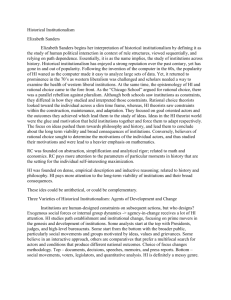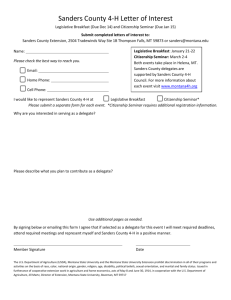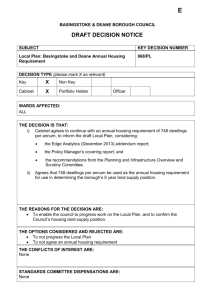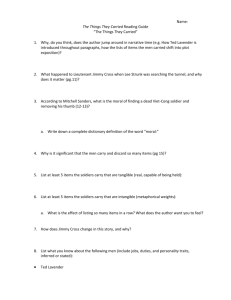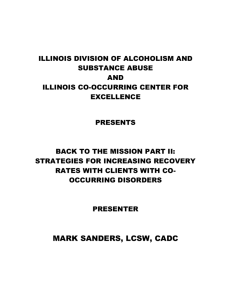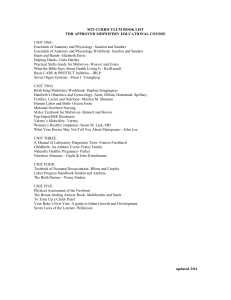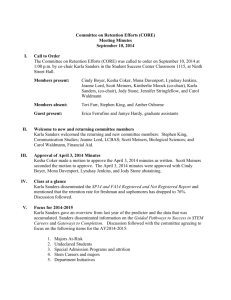Rhetorical Criticism of a Speech
advertisement
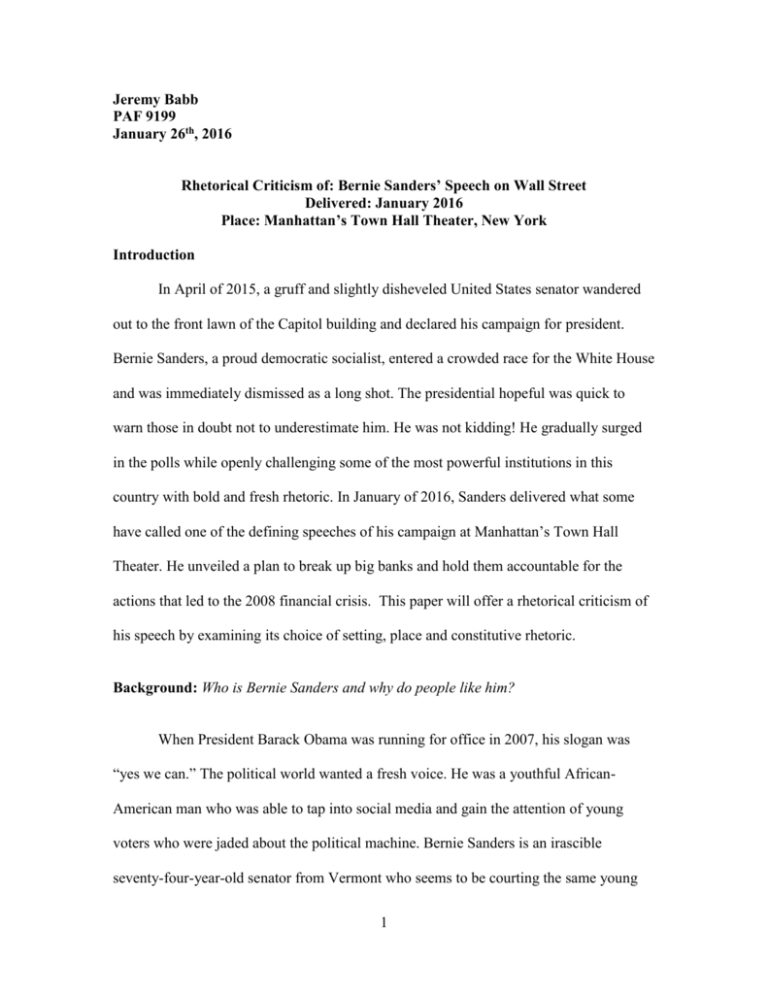
Jeremy Babb PAF 9199 January 26th, 2016 Rhetorical Criticism of: Bernie Sanders’ Speech on Wall Street Delivered: January 2016 Place: Manhattan’s Town Hall Theater, New York Introduction In April of 2015, a gruff and slightly disheveled United States senator wandered out to the front lawn of the Capitol building and declared his campaign for president. Bernie Sanders, a proud democratic socialist, entered a crowded race for the White House and was immediately dismissed as a long shot. The presidential hopeful was quick to warn those in doubt not to underestimate him. He was not kidding! He gradually surged in the polls while openly challenging some of the most powerful institutions in this country with bold and fresh rhetoric. In January of 2016, Sanders delivered what some have called one of the defining speeches of his campaign at Manhattan’s Town Hall Theater. He unveiled a plan to break up big banks and hold them accountable for the actions that led to the 2008 financial crisis. This paper will offer a rhetorical criticism of his speech by examining its choice of setting, place and constitutive rhetoric. Background: Who is Bernie Sanders and why do people like him? When President Barack Obama was running for office in 2007, his slogan was “yes we can.” The political world wanted a fresh voice. He was a youthful AfricanAmerican man who was able to tap into social media and gain the attention of young voters who were jaded about the political machine. Bernie Sanders is an irascible seventy-four-year-old senator from Vermont who seems to be courting the same young 1 audience that Obama did in 2008. “Young people like Bernie Sanders because he sounds like a warm old record. He’s been talking about the injustices done to working people by unequal income distribution for more than forty years. His voice, often hoarse from his habitually loud and impassioned speeches, even has the crackle of worn vinyl (Talbot, 2015).” At each rally, Sanders reaffirms his commitment to banish money from politics: he has sharply criticized the Supreme Court’s 2010 decision, in Citizens United, to permit unlimited campaign spending by corporations, and has lamented the outsize influence exerted by billionaires. Sanders’s authenticity, didacticism, and indifference to appearances are central to his appeal. He has been known as a democratic socialist for decades and he does not shy away from the term. Sanders and his “social-media-driven fans have given socialism a bit of a P.R. makeover (Talbot, 2015).” Sites like Reddit and Twitter have popularized videos of Sanders explaining why he identifies as a socialist, and what it means to him, in a really positive light. Socialism had a retro connection to Communism according to the New Yorker and the term was originally thrown at Sanders as a damning label by his opponents. But for his supporters it isn’t a deterrent, it’s a badge of honor and constitutes his identity. Historical Context To fully understand why the speech that Bernie Sanders delivered garnered so much attention requires a brief look back through American history to see where the foundation of the country’s ideologies were built. In 2012, businessman and Massachusetts governor Mitt Romney was campaigning for president. In one of his speeches, he addressed a group of wealthy supporters by dismissing supporters of 2 President Barack Obama as entitled “victims” who take no responsibility for their livelihood. “There are 47 percent who are dependent upon government to care for them and these are people who pay no income tax and believe they are entitled to health care, to food, to housing, to you name it,” Romney said. What he largely ignored was the amount of citizens in the armed forces, the disabled and retired people who pay no federal income tax or the vast majority of Americans, rich and poor, who benefit from federally funded “handouts” such as the privilege of highways, public transportation, housing subsidies and tax incentives. The main part of Romney’s argument that should be focused on is the word, “victims.” The 47 percent he is talking about are “victims” of century old ideologies that suggest that people are poor because of their character. They are “victims” of a marketplace that denies them access to housing, healthcare, education and jobs to climb the social ladder. They are also “victims” of policies that relegate them to the margins of society, creating this dependency on government and entitlements. It takes an understanding of America’s attitude towards the poor and of America’s social and economic policies throughout the decades to see that this country created the 47 percent that Romney says is dependent upon the government. One of the first traditions that came out British colonialism in America was Calvinism. Calvinist’s believed that “if you worked hard and prospered, you were destined to be rich, but if you were poor and suffered, it meant you were destined to be poor, and your poverty reflected your moral failings” (Blau, 2010, p. 239). In the late 1800’s, eugenics formulated that people inherited an unwillingness to work. “Social Darwinism argued that in the struggle for survival those who are strongest, smartest, and most fit for the competition will succeed and prosper. Society’s helping the downtrodden impeded individual freedom and 3 retarded social progress” (Blau, 2010, p. 160). In 1818, the Society for the Prevention of Pauperism issued a report asking for the need to get rid of unsavory poor people from the community. The report failed to mention “the twin burden of urban laboring people: low wages and few jobs. Instead the report framed poverty as a moral failure, arguing that the habits and vices of the poor need to be remade” (Garb, 2012, p. 32). This issue of low wages and no work has been ever-present throughout the decades and came again in modern times with the Great Recession. There were millions of American’s who gave up on ever finding a job and their incomes and livelihoods rapidly decreased while their dependency on the government increased. Mitt Romney and many conservatives tried to paint these people as being responsible for their circumstances when it has been failed policies and corrupt businessmen that have led to this government dependency. As a result of globalization, privatization and commodification, there remains this constant divide between whether the market increases efficiency in all aspects of life or if the capitalist system, with Wall Street at its center, is to blame for wide gap between the rich and the poor. Bernie Sanders’ speech was an attack on greed in big business. Rhetorical Criticism: An analysis of setting and place All rhetorical situations occur in specific settings or contexts or environments. The specific constraints that affect a setting include “the time of speaker and audience, the place of speaker and audience, and the community or conversation in which speakers and/or audiences engage (Sproat et al., 2016). The specific places of speakers and their audiences affect the ways that speech is made and received. Bernie Sanders was going to deliver a scathing condemnation of financial greed. He was going to attack a system that 4 wields considerable power through every aspect of society, from politics, to the media, to healthcare, to the environment. What better place to attack Wall Street, than on its own turf, in New York. That alone showed his courage. Bernie Sanders began his speech with: “The American people are catching on. They understand that something is profoundly wrong when, in our country today, the top one-tenth of 1 percent own almost as much wealth as the bottom 90 percent and when the 20 richest people own more wealth than the bottom 150 million Americans – half of our population. They know that the system is rigged when the average person is working longer hours for lower wages, while 58 percent of all new income goes to the top 1 percent. They also know that a handful of people on Wall Street have extraordinary power over the economic and political life of our country. As most people know, in the 1990s and later, the financial interests spent billions of dollars in lobbying and campaign contributions to force through Congress the deregulation of Wall Street, the repeal of the Glass-Steagall Act and the weakening of consumer protection laws in states.” Sanders delivered his speech in front of several American flags and behind a podium that read, “a future to believe in.” The location was right and the staging was deliberate. Despite his manner of speech, Sanders was impassioned. The language and topic of the speech required it. You cannot take on the might of Wall Street without language that is powerful. But his speech was meant for two audiences simultaneously. “For those who are attracted to his campaign by its focus on social inequality, its purpose was to bolster the senator’s credentials as an opponent of the criminal activities of Wall Street. For the financial elite and the corporate-controlled Democratic Party, the speech was meant to be the equivalent of a reassuring wink that, notwithstanding his populist rhetoric, Sanders could be counted on to defend the interests of American capitalism (Hall, 2016).” Sanders delivered his remarks to an invitation only crowd. The select character of the audience stood in contrast to earlier campaign appearances at which 5 Sanders addressed tens of thousands of people lured by his stated opposition to the “billionaire class” and social inequality and his talk of a “political revolution.” In attendance at the speech, billed in advance as a major policy statement, were numerous Democratic Party establishment figures from the New York City area. There were mentions and allusions to progressives like Barack Obama, Franklin Delano Roosevelt, Theodore Roosevelt and Elizabeth Warren. But to show unity with those who support fair and equitable business practices, the event was emceed by New York State Senator James Sanders, who, during his time on New York’s City Council, supported the administration of the billionaire former mayor Michael Bloomberg. This speech was delivered at the right time and the right place to send the right message. The media picked up on its energy and it shot Sanders ahead of his biggest party competitor, Hilary Clinton, in several polls. The choosing of Town Hall was intentional, not only because it is a few miles from Wall Street, but because it is synonymous with important issues and movements of the day. Its mantra has always been, “not a bad seat in the house,” and Sanders’s speech reaffirmed that. Constitutive Rhetoric Through the use of several rhetorical devices, Sanders successfully formed a collective identity for the audience. He is not the typical dynamic speaker, yet this speech worked as a result of the use of repetition, ideographs and constitutive rhetoric. The best line in the entire speech is when Sander’ says, “Greed is not good,” in a rebuttal to the famed character from the movie “Wall Street,” Gordon Gekko. He adds, “In fact, the greed of Wall Street and corporate America is destroying the very fabric of our nation.” 6 Throughout the speech, Sanders drove home a damning assessment of the country’s largest commercial banks saying, in part, that the behavior of their top executives was patently criminal and that those corporations should never receive the kind of bailouts they were extended following the 2008 financial collapse. His first 100 days as president would include compiling a list of banks that are “too big to fail” so he can shrink them until they no longer “pose a catastrophic risk to the United States economy without a taxpayer bailout.” He appeals to values such as fairness, honesty and equality to form a symbiotic relationship with the audience so they can be united in the cause to reform economic policies. Below are some of the best examples of Sanders using rhetorical devices to constitute the audience: “Let me read you a few headlines and you tell me how it makes sense that not one executive was prosecuted for fraud. CNN Headline, May 20, 2015: “5 big banks pay $5.4 billion for rigging currencies.” Those banks include JPMorgan Chase and Citigroup. Headline from the International Business Times (February 24, 2015): “Big Banks Under Investigation For Allegedly Fixing Precious Metals Prices.” The Banks under investigation included Goldman Sachs and JPMorgan Chase. Headline from The Real News Network (November 26, 2013): “Documents in JPMorgan settlement reveal how every large bank in the U.S. has committed mortgage fraud.” Headline from The Washington Post (March 14, 2014): “In lawsuit, FDIC accuses 16 big banks of fraud, conspiracy,” which included Bank of America, Citigroup and JP Morgan Chase. Headline from the Guardian (April 2, 2011): “How a big U.S. bank laundered billions from Mexico’s murderous drug gangs.” This article talks about how Wachovia (which was acquired by Wells Fargo) aided Mexican drug cartels in transferring billions of dollars in illegal drug money. Here is what the federal prosecutor (Jeffrey Sloman) said about this: “Wachovia’s blatant disregard for our banking laws gave international cocaine cartels a virtual carte blanche to finance their operations.” Yet, the total fine for this offense was less than 2% of the bank’s $12.3 billion profit for 2009 and no one went to jail. No one went to jail. And, if that’s not bad enough, here’s another one. Headline: The Wall Street Journal, February 9, 2011: “J.P. Morgan Apologizes for Military Foreclosures.” Here is a case where JP Morgan Chase, the largest bank in America, wrecked the finances of 4,000 military families in violation of the Civil Service Members Relief Act, yet no one went to jail.” 7 Sanders uses anaphora frequently in his speech and he uses it well. He is often criticized for not having an actionable plan to accomplish his agenda, but in this speech he repeated the word “further,” as he outlined how the Federal Reserve could level the playing field for working Americans. Conclusion It remains to be seen if an avowed socialist can win the White House. This country has gone to war for capitalist ideals and the influence of Darwinism, Calvinism and globalization loom large. Bernie Sanders is seen as affront to everything American by some. Since he announced his candidacy he has always been perceived as an underdog. However, he has now captured the attention of everyone. His speech at Town Hall on Wall Street reform helped to raise his national prominence. It showed that he is not to be underestimated. Sanders was able to effectively use setting and place to drive his message home. He successfully used images, symbols and language to constitute the audience. “I will rein in Wall Street so they cannot crash our economy again,” he said. “Will the folks on Wall Street like me? No. Will they begin to play by the rules if I am president? You better believe it.” After that speech, it is a certainty that his audience believes him. 8 References Blau, Joel. (2010). The Dynamics of Social Welfare Policy. Oxford University Press, 3rd edition . Garb, Maggie. (2012). A Poverty of Empathy. In These Times, Vol. 36, p32. Hall, Tom. (2016). “Bernie Sanders poses as an opponent of Wall Street.” World Socialist, 6 January 2016. Web. 23 Jan. 2016 Romney, Mitt. (2012). Associated Press Sanders, Bernie. (2016). “Speech on Wall Street Reform.” Marketwatch, 6 January 2016. Web. 21 Jan. 2016. Sproat, Ethan & Allen Brizee, “Rhetorical Situations.” Purdue OWL. Web. 22 Jan. 2016 Talbot, Margaret. (2015). “The Populist Prophet.” The New Yorker, 12 October, 2015. Web. 22 Jan. 2016 9
